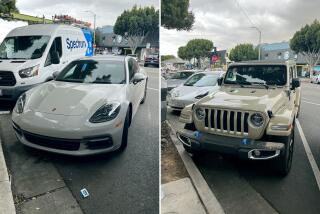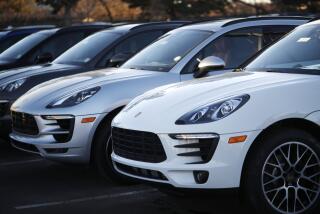SUV? Yes, a Porsche
- Share via
Sometimes even those things that strike most of us as silly excesses have a reason for being.
Take Porsche’s 2004 Cayenne sport utility vehicle.
It looks great, handles like a dream, goes like a bat out of Hades on the highway and creeps and crawls along with the best of the factory-built 4x4s on rugged off-road terrain.
But it is the answer to a question very few outside of Porsche’s executive offices in Stuttgart, Germany, have ever asked:
Does the world need a Porsche SUV?
Especially the 450-horsepower, turbocharged version, which costs almost $90,000, drinks only premium gasoline, rates an abysmal 14 miles per gallon in the city and 18 on the open road with a feather-foot behind the wheel and is the world’s fastest production SUV, with a top speed of 165 mph?
Most reasonable people would say no.
But Porsche doesn’t make cars that people need, company executives say. It makes cars that people want.
And the Cayenne, Porsche fervently hopes, is one such vehicle.
The Cayenne’s chief designer, Ferdinand A. Porsche -- grandson and namesake of the company’s legendary founder -- adds that although people might not need it, Porsche does. Porsche is one of the few remaining small, independent car companies, and the Cayenne is the sports car maker’s bid to broaden its market and take advantage of the SUV gold rush.
After all, if people are willing to pay inflated prices for Cadillac, Lincoln, BMW and Mercedes-Benz SUVs, why should Porsche sit on the sidelines?
That’s the reason for this excess.
And for now the decision to make the Cayenne seems a sound one.
Despite howls of protest from Porsche purists when the company said it would build an SUV, Porsche’s prelaunch orders gobbled up the first few months’ production of Cayennes, and the present U.S. sales pace of 1,400 a month (3,600 sold between the March 15 market launch and the end of May) makes Cayenne the best-selling model in Porsche’s three-vehicle lineup.
In May, Porsche sold more than twice as many of its SUVs -- the $56,665 normally aspirated, 340-horsepower S model and the $89,665 Turbo model -- as its two-seater Boxster and Boxster S models, and 50% more than its 911 Carrerras, Turbos and GT2s combined.
Despite the Cayenne’s steep base prices, most buyers also added a few options. The average selling price in the United States, says Porsche Cars of North America spokesman Martin Peters, is $62,035 for the S model and $94,115 for the Turbo.
Competitors include the rest of the luxury and performance SUV crowd, including the Mercedes-Benz ML and BMW X5 families, Land Rover (and for some the larger Range Rover as well) and the Lexus GX 470.
Porsche wants to double company sales globally and sees the still-growing North American SUV market, especially the luxury-performance end of it, as a crucial part of the strategy.
The automaker plans to build 25,000 Cayennes a year, with half of them slated for the United States. The other Cayennes are heading for markets in Europe, Latin America and the Middle East.
Whether there are enough SUV buyers in the U.S. pipeline to sustain that pace is still to be determined, but Peters says the company isn’t worried -- not even with the jointly developed Volkswagen version, called the Touareg, entering the market this week.
The VW is more utilitarian, less powerful and priced about 40% less than the Cayenne. Porsche’s stance is that VW people aspire to Porsches, not the other way around.
As for me, after half a day behind the wheel, I like the Cayenne, a lot. But even if I had the cash to buy one, I’d pass.
Instead, for the same money as the low-end Cayenne S, I would buy a $44,000 Boxster to satisfy my Porsche needs and use the remaining bucks on a good secondhand 4x4 for my occasional off-roading ventures.
But that’s me.
If you absolutely must have a Cayenne to show up those other guys (or girls) at the country club as they pull up in their Bimmer and Benz sport utes (or if you are just curious about what the fuss is), here are the basics:
My ride was a gleaming black Cayenne Turbo, part of a caravan of four similarly equipped SUVs that Porsche sent out on a cross-country trek in early May.
The drive took seven days, starting in Santa Monica and ending in New York City. I participated in the first leg, from the L.A. area to San Diego, then inland to Redlands and up over the San Bernardino Mountains to Big Bear via the steep, twisting Clark’s Grade off-road trail [Highway 1, May 29, 2002].
I spent the first few hours as a back seat passenger on the way to San Diego and can attest that there is plenty of room and comfort in the rear portion of the passenger cabin, with ample space behind the leather-clad seats for luggage and other stuff.
There were four of us in the Cayenne, with overnight bags, camera gear, briefcases and laptop computers, plus a few spare parts, a cooler full of soft drinks and snacks and a box of brochures. And that was just in the rear cargo area. Each Cayenne also was hauling a rooftop carrier crammed with spare parts and tires and, on a special tailgate rack, a fancy Italian motor scooter that was to be auctioned at the end of the trek.
Add the Turbo’s base weight of 5,192 pounds to all that extra gear and the 800 or so pounds of people on board, and we might have expected to be in for a sluggish ride, lagging on the slightest hint of a hill and wobbling on the rough off-road portions of the trip.
Wrong.
The Cayenne pulled us around as if we weren’t there. Performance of the loaded SUV, of course, wouldn’t compare with that of an empty one, but SUVs are all about hauling stuff.
The power to move the Cayenne and its loads comes from Porsche’s new 4.5-liter V-8 (the first in a Porsche since the 928 was dropped from the lineup in 1995), with a six-speed Tiptronic auto-manual transmission (an automatic that can be shifted manually without a clutch). A six-speed manual is expected for the Cayenne S next year.
The base model’s 340 horses are augmented by 310 pound-feet of torque, or pulling power, available as early as 2,500 rpm. The 450-horsepower Turbo (it actually uses two turbochargers) provides 457 pound-feet of torque available as early as 2,250 rpm.
Porsche says the Cayenne S will accelerate from a standstill to 62 mph in 7.2 seconds, while the Turbo makes the trip in just 5.6 seconds. Top speed for the S is 150 mph.
On the safety side, both models have dual front air bags, driver and passenger side air bags and side-curtain air bags that provide head protection in both rows of seats.
Porsche’s latest traction and stability control systems are standard, as are massive 13.5-inch disc brakes on all four wheels (with six-piston calipers up front and four-piston calipers on the rear) to provide plenty of stopping power.
We weren’t able to push the Cayenne to its limits on our leg of the trek. But on both the twisty inland San Diego County roads and at 85 mph on the freeway, the SUV proved to be nimble, easy to handle and remarkably responsive, with almost none of the body roll or freeway bounce common in the genre.
It was pretty much like driving a Porsche sports car, except with a lot more elbow room and a much higher seating position. And this is a Porsche that can tow 7,700 pounds and carry a 1,600-pound payload. Maximum cargo area is 62.4 cubic feet; it drops to 19.6 cubic feet with the rear seats in use, better than in the BMW X5 but not quite as good as the Mercedes-Benz ML.
Cayennes come with all-wheel drive, with a normal torque split that puts 68% of the power to the rear wheels.
In automatic mode, the system shifts power on demand to the wheels that need it. For off-roading there’s a two-speed transfer case with low range and a manual mode that can lock the center differential at a 50-50 power split.
For serious dirt pounding (although one suspects that few Cayenne drivers will subject their expensive sheet metal to the dings and scratches that are part of true off-roading), there is an optional package that includes underbody skid plates, a locking rear differential and an easy-disconnect system for the anti-sway bars to permit greater wheel travel.
Even with the scooter on the back and a rooftop carrier that made us top-heavy, we took the 12-mile Clark’s Grade path with no problems and just as easily as I had run it a few months earlier in a Hummer H2.
Standard suspension is coil springs over struts with an additional set of springs to control sideways movement. The Turbo ups the ante with air suspension that adjusts the ride height according to vehicle speed. Ground clearance can be varied from 6.2 inches to 10.7 inches.
The system also provides three ride and body-roll settings to provide just the right balance on all types of surfaces.
Wind noise was minimal on the highway -- no SUV, no matter how sleek, can eliminate it -- and the body was amazingly free of creaks and groans during the off-road portion of the drive.
Leather upholstery is standard, and the interior is typical Porsche techno-luxury, all black with silver metal trim. The main analog instruments are easy to see and read, and controls, for the most part, are easy to use.
Final words: A fine machine with no real purpose other than thumbing your nose at the rest of the pack. Porsche figures that most of its sports car owners have someone else’s SUV in their garage and might want to replace it with a Porsche. Still, if you can afford it, you’re not likely to be disappointed.






